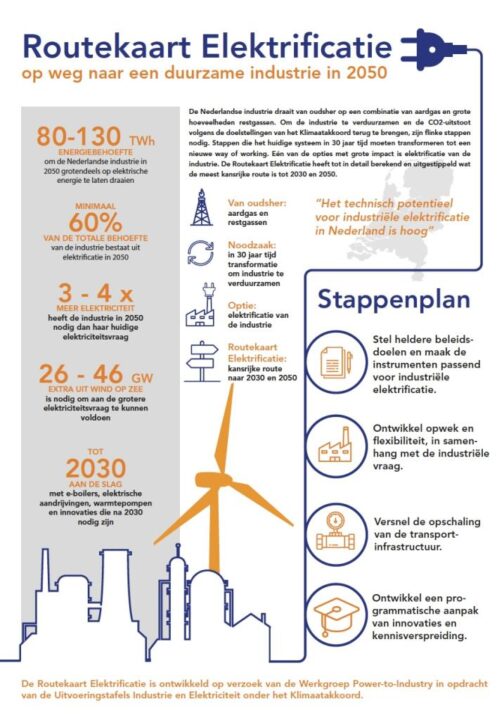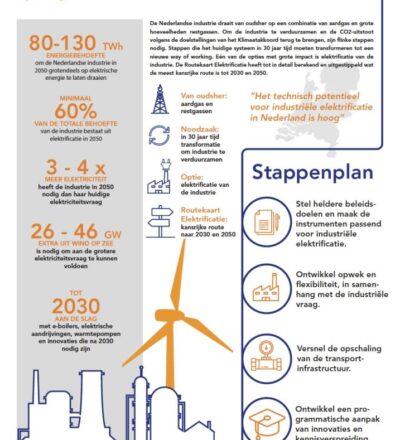A minimum of 30 TWh of additional electricity is needed for industry, and a further 10GW of wind power needs to be developed offshore, by 2030. By 2050, between 80 and 130 TWh of electricity will be needed for industrial energy. This detailed calculation was done for the first time in the Electrification Roadmap that was presented today. Electrification will meet at least 60% of industry’s total needs. The Roadmap sets out what we need to make the transition to electrification in industry.
Dutch industry has traditionally run on a combination of natural gas and large quantities of residual gases. Significant steps are needed to make industry more sustainable and cut CO2 emissions if the Netherlands is to meet the goals set out in the Climate Agreement. The aim of these steps is to transform the current system into a new way of working within 30 years. To meet these goals, electrification is a must. The Electrification Roadmap has calculated and mapped out in detail the most promising route to 2030 and then on to 2050.

Today, Rob Kreiter on behalf of the Power-to-Industry Working Group, Carolien Gehrels and Jan Jacob van Dijk, Chairs of the Industry & Electricity Implementation Boards under the Climate Agreement, handed over the Roadmap to Sandor Gaastra, Director-General of Climate and Energy at the Ministry of Economic Affairs and Climate Change.
Not a time for dithering
It is now up to the government, grid operators, industry, the energy sector, and other stakeholders to put meat on the bone. As the authors of the Roadmap see it, this is no time for dithering. The Roadmap provides the tools needed to get started right away, both to industry and the energy sector, and to government and politicians.
Huge technical potential for industrial electrification in the Netherlands
If we want to drastically reduce, through electrification, the amount of CO2 emissions Dutch industry produces, we will need a huge amount of additional generating capacity. That additional amount of electricity that industry will use, both directly and indirectly (via conversion to hydrogen), could reach some 130 TWh by 2050. This is on top of existing electricity demand from industry, demand from new industries, and growing demand from other sectors such as data centers. We are talking about more than the current total electricity consumption in the Netherlands (thus including households, offices, and so on) and 3 to 4 times more than industry’s current electricity demand.
The minimum amount of electricity and green hydrogen that will have to be made available to meet emission-reduction targets, is 80 TWh. This will also require the maximum use of other emissions-reduction options such as energy conservation, green gas, geothermal, and the current CCS cap. The Roadmap concludes that the required 80 TWh for industry is a clear no-regret target, and that it will be very likely still not enough. To meet demand from industry, additional wind turbines will need to be built at sea, generating an additional 26 to 46 GW. In the short term, in the period up to 2030, industry can get started, with hybrid and other e-boilers, electric drives, and heat pumps. Further innovations will be needed after 2030.
Step-by-step plan for taking advantage of opportunities
Intensive cooperation from all players in the chain will be need in order to take advantage of these opportunities. Government, electricity producers, grid operators, academia, and industry must now start choosing policies and investments that will lead to the rollout of electrification in the near term while preparing the path to 2050. The government has an important role to play here in initiating and coordinating the process, and in creating the right conditions for industrial electrification.
The Roadmap provides a step-by-step plan for industrial electrification:
1. Set clear policy goals, and make instruments appropriate for industrial electrification
Industry should create a minimum of 30 TWh of additional capacity by 2030. Current subsidies (SDE++) should provide greater scope for electrifying industry. In order to achieve the 2030 targets, this push must come within the next two years.
2. Develop generation and flexibility, in keeping with industrial demand
Develop at least an additional 10 GW of offshore wind by 2030. Prepare to create an additional 26 to 46 GW of capacity by 2050. The development of generation and demand will require a national assurance mechanism that will give certainty to both sectors.
3. Accelerate the scale-up of the transport infrastructure
More transmission capacity for electricity and hydrogen infrastructure must be worked on urgently between now and 2030. Decisions on the additional large-scale reinforcement of electricity grids and further strengthening of the national hydrogen infrastructure into a national backbone are needed by 2022. This is why the Roadmap calls for shorter permit processes, and for better and secure data exchange.
4. Develop a programmatic approach to innovations and the dissemination of knowledge
Innovation, scaling up, and reducing risks and costs are key to creating additional capacity on the scale required. This will require a programmatic approach to innovations with a greater commitment to electrification, organizing knowledge exchange between and among companies, and training enough technically qualified people.
About the Electrification Roadmap
The Roadmap was developed at the request of the Power-to-Industry Working Group and presented to the Industry and Electricity Implementation Boards under the Climate Agreement. The authors are TKI Energy and Industry (part of Top Sector Energy), DNV, and TNO, together with many involved stakeholders and partners. The Roadmap was also received by the Ministry of Economic Affairs and Climate, and presented to the House of Representatives by the State Secretary.
Download the Roadmap Electrification.
Acknowledgement
This project is co-funded with subsidy from the Topsector Energy by the Ministry of Economic Affairs and Climate Policy.
